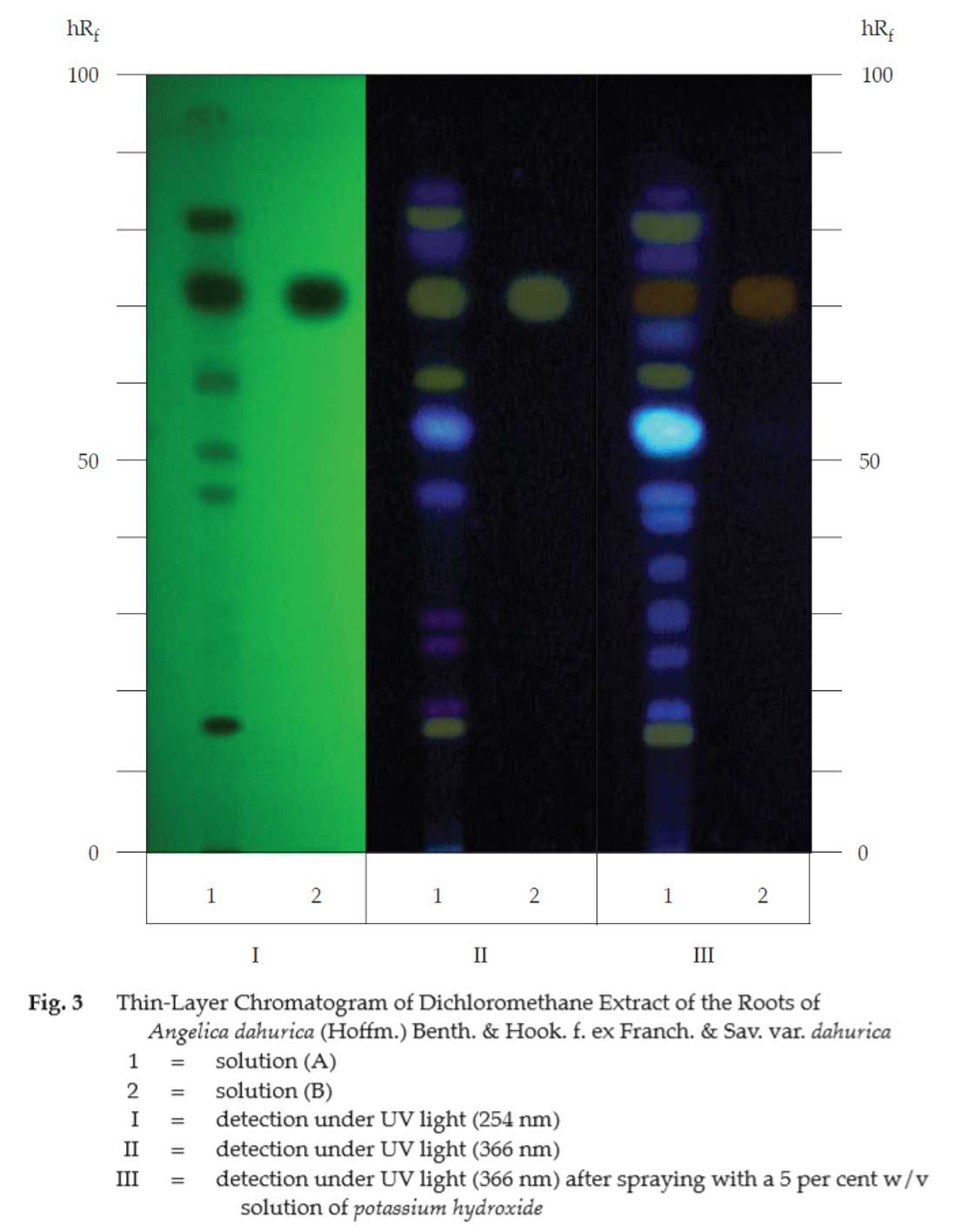ตำรามาตรฐานยาสมุนไพรไทย
Thai Herbal Pharmacopoeia
สำนักยาและวัตถุเสพติด กรมวิทยาศาสตร์การแพทย์ กระทรวงสาธารณสุข
Bureau of Drug and Narcotic, Department of Medical Sciences, Ministry of Public Health(Tinospora crispa (L.) Hook.f. & Thomson)
(Nelumbo nucifera Gaertn.)
(Centella asiatica (L.) Urb.)
(Centella Dry Extract)
(Centella Cream)
(Mesua ferrea L.)
(Piper sarmentosum Roxb.)
(Piper sarmentosum Roxb.)
(Pterocarpus santalinus L. f.)
(Santalum album L.)
(Senna tora (L.) Roxb.)
(Senna alata (L.) Roxb.)
(Senna Alata Tea)
(Piper retrofractum Vahl)
(Myristica fragrans Houtt)
(Andrographis paniculata (Burm. f.) Nees)
(Andrographis Capsules)
(Allium ascalonicum L.)
(Ocimum tenuiflorum L.)
(Curcuma longa L.)
(Turmeric Capsules)
(Turmeric Dry Extract)
(Turmeric Dry Extract Capsules)
(Arcangelisia flava (L.) Merr.)
(Curcuma sp.)
Harrisonia perforata (Blanco) Merr.
(Aristolochia pierrei Lecomte)
(Zingiber officinale Roscoe)
(Ginger Capsules)
(Ginger Tea)
(Cassia fistula L.)
(Nardostachys jatamansi (D. Don) DC.)
(Angelica sinensis (Oliv.) Diels)
Artemisia annua L.
(Ligusticum sinense Oliv. cv. Chuanxiong)
(Neopicrorhiza scrophulariiflora Pennell)
(Atractylodes lancea (Thunb.) DC.)
(Aucklandia lappa Decne)
(Terminalia chebula Retz.)
(Angelica dahurica (Hoffm.) Benth. & Hook. f. ex Franch. & Sav. var. dahurica)
(Kaempferia parviflora Wall. ex Baker)
(Hibiscus sabdariffa L.)
(Roselle Tea)
(Allium sativum L.)
(Zingiber zerumbet (L.) Sm.)
(Wurfbainia testacea (Ridl.) Škorničk.& A. D. Poulsen)
(Cannabis sativa L.)
(Myristica fragrans Houtt)
(Dracaena cochinchinensis (Lour.) S. C. Chen)
(Ficus racemosa L.)
(Hyptis suaveolens (L.) Poit.)
Clerodendrum indicum (L.) Kuntze
(Phyllanthus emblica L.)
(Citrus hystrix DC.)
(Citrus hystrix DC.)
(Areca catechu L.)
(Momordica charantia L.)
Moringa oleifera Lam.
(Aegle marmelos (L.) Corrêa)
(Solanum trilobatum L.)
(Morus alba L.)
Gynostemma pentaphyllum(Thunb.)
Makino
(Clinacanthus nutans (Burm. f.) Lindau)
(Cissus quadrangularis L.)
(Mimusops elengi L.)
(Zingiber montanum (J. König) Link. ex A. Dietr.)
(Piper betle L.)
(Capsicum annuum L.)
(Capsicum Oleoresin)
(Capsicum Gel)
(Piper nigrum L.)
(Piper nigrum L.)
(Eurycoma longifolia Jack)
(Thunbergia laurifolia Lindl.)
(Piper wallichii (Miq.) Hand.-Mazz.)
Senna garrettiana (Craib) H. S. Irwin & Barneby
(Terminalia bellirica (Gaertn.) Roxb.)
(Terminalia chebula Retz.)
(Caesalpinia bonduc (L.) H. Roxb.)
(Tarlmounia elliptica (DC.) H. Rob., S. C. Keeley, Skvaria & R. Chan)
(Hog Creeper Vine Dry Extract Capsiles)
(Hog Creeper Vine Dry Extract)
(Brachypterum scandens (Roxb.) Miq.)
(Lepidium sativum L.)
(Nigella sativa L.)
(Cuminum cyminum L.)
(Foeniculum vulgare Mill.)
(Plantago ovata Forssk.)
(Pimpinella anisum L.)
(Carum carvi L.)
(Anethum graveolens L.)
(Trachyspermum ammi (L.) Sprague)
Albizia procera (Roxb.) Benth.
(Acorus calamus L.)
(Tiliacora triandra (Colebr.) Diels)
Cyanthillium cinereum (L.) H. Rob.
(Orthosiphon aristatus (Blume) Miq.)
Murdannia loriformis (Hassk.) R. S. Rao & Kammathy
(Capparis micracantha DC.)
(Chrysopogon zizanioides (L.) Roberty)
(Cyperus rotundus L.)
(Cannabis sativa L.)
(Syzygium aromaticum (L.) Merr. & L. M. Perry)
(Boesenbergia rotunda (L.) Mansf.)
(Acanthus ebracteatus Vahl)
(Acanthus ilicifolius L.)
(Kaempferia galanga L.)
(Curcuma comosa Roxb.)
Betula alnoides Buch.-Ham. ex D. Don
Cannabis sativa L.
Carthamus tinctorius L
Mitragyna speciosa (Korth.) Havil
Mallotus repandus (Rottler) Müll. Arg
Azadirachta indica A. Juss. var. siamensis Valeton
Azadirachta indica A. Juss. var. siamensis Valeton
Punica granatum L.
Rhinacanthus nasutus (L.) Kurz
Baliospermum solanifolium (Burm.) Suresh
Curcuma aeruginosa Roxb
Boesenbergia kingii Mood & L. M. Prince
Senegalia rugata (Lam.) Britton & Rose
Acacia concinna (Willd.) DC.
Senegalia rugata (Lam.) Britton & Rose
Acacia concinna (Willd.) DC.
Senna alexandriana Mill. var. alexandriana
Cassia acutifolia Delile, Cassia angustifolia Vahl
Butea superba Roxb. ex Willd.
[Plaso superba (Roxb. ex Willd.) Kuntze, Rudolphia superba (Roxb. ex Willd.) Poir.
Pueraria candollei Graham
ex Benth. var. mirifica (Airy Shaw & Suvat.) Niyomdham
Streblus asper Lour.
Suregada multiflora (A. Juss.) Baill. (Gelonium
multiflorum A. Juss.
Dahurian Angelica Root is the dried root of Angelica dahurica (Hoffm.) Benth. & Hook. f. ex Franch. & Sav. var. dahurica (A. macrocarpa H. Wolff) (Family Umbelliferae), Herbarium Specimen Number: see Additional information 1, Crude Drug Number: DMSc 1146.
Constituents Dahurian Angelica Root contains furanocoumarins such as imperatorin, isoimperatorin, phellopterin, etc.
Description of the plant (Figs. 1a, 1b) Perennial herb 1 to 2.5 m tall; s tem purplish green, hollow, pubescent above; root s tout, cylindrical. Leaves pinnately or ternately compound, alternate; blade triangular-ovate in outline, 10 to 50 cm long, 25 to 40 cm wide; leaflets sessile, terminal leaflet deeply 3-lobed, blade usually oblong or ovate-elliptic, 4 to 10 cm long, 1 to 5 cm wide, apex acute to acuminate, base slightly decurrent, margin whitecartilaginous, sharply serrate, pubescent along nerves adaxially, upper leaves reduced, basal and lower leaves long-petiolate, broadly dilated at base into saccate-inflated sheaths. Inflorescence compound umbel, 10 to 30 cm in diameter; peduncle 5 to 20 cm long, scabrous; bract(s) absent or 2, broadly lanceolate; bracteoles many, linear-lanceolate, scarious. Flowers white, 18 to 40(–70) per umbel; pedicellate, scabrous; calyx teeth obsolete; petals 5, obovate, apex incurved; ovary inferior, glabrous or pubescent, 2-loculed, 1 ovule per locule, s tylopodium shortly conic. Fruit schizocarp, suborbicular, 4 to 7 mm long, 4 to 6 mm wide, dorsal ribs prominent, obtusely thick-rounded, much wider than furrow, lateral ribs broad-winged; vitta(e) 1 in each furrow, 2 on commissure; split into 2 single-seeded mericarps. Seed plane or slightly concave.
Description Odour, aromatic; taste, pungent and bitterish.
Macroscopical (Fig. 1a) Long-conical, 10 to 25 cm long, 1.5 to 2.5 cm in diameter. Externally greyish brown or yellowish brown, root stock obtusely quadrangular or subrounded, with longitudinal wrinkles, rootlet scars and lenticel-like transverse protrudings, some of them arranged in 4 longitudinal rows. Apex with dented stem scar. Texture compact, fracture white or greyish white and starchy, cambium ring brown, subsquare or subrounded, scattered with many brown oil dots in bark.
Microscopical (Figs. 2a, 2b) Transverse section of the root shows periderm, cortex, phloem, cambium, and xylem; with schizogenous oil cavities distributed throughout. Periderm, 5 to 10 layers of rectangular, thin- and slightly wavy-walled cork cells. Cortex, narrow, with polygonal or elliptical parenchyma cells. Phloem, a broad zone of polygonal parenchyma and phloem rays. Cambium layers, containing subsquare or subround cells. Xylem, containing vessels, radially arranged in row, with polygonal or subround xylem parenchyma cells and xylem rays. Medullary ray, 2 to 3 rows, rectangular and elliptical cells. Parenchyma cells, containing starch grains and some with prismatic crystals of calcium oxalate.
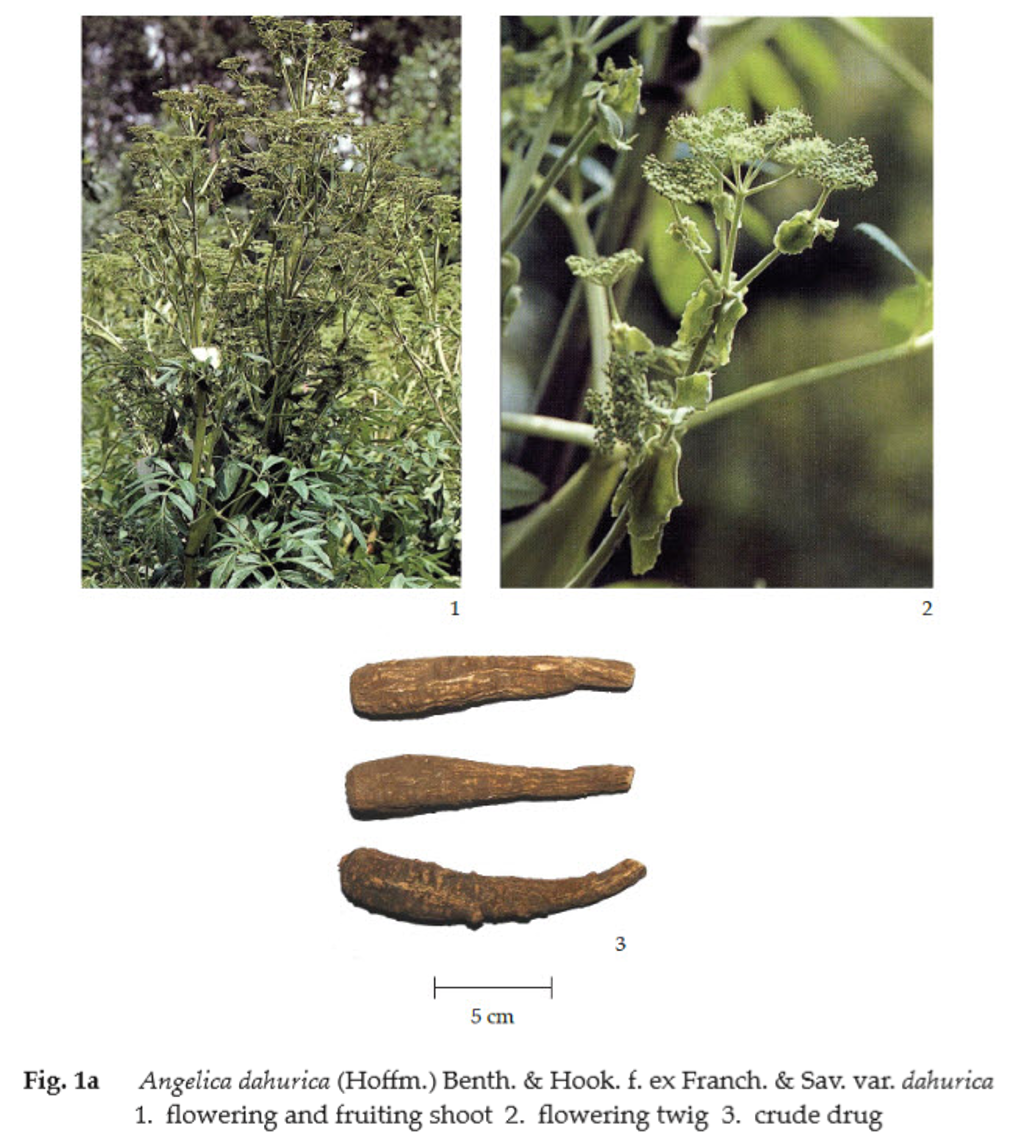
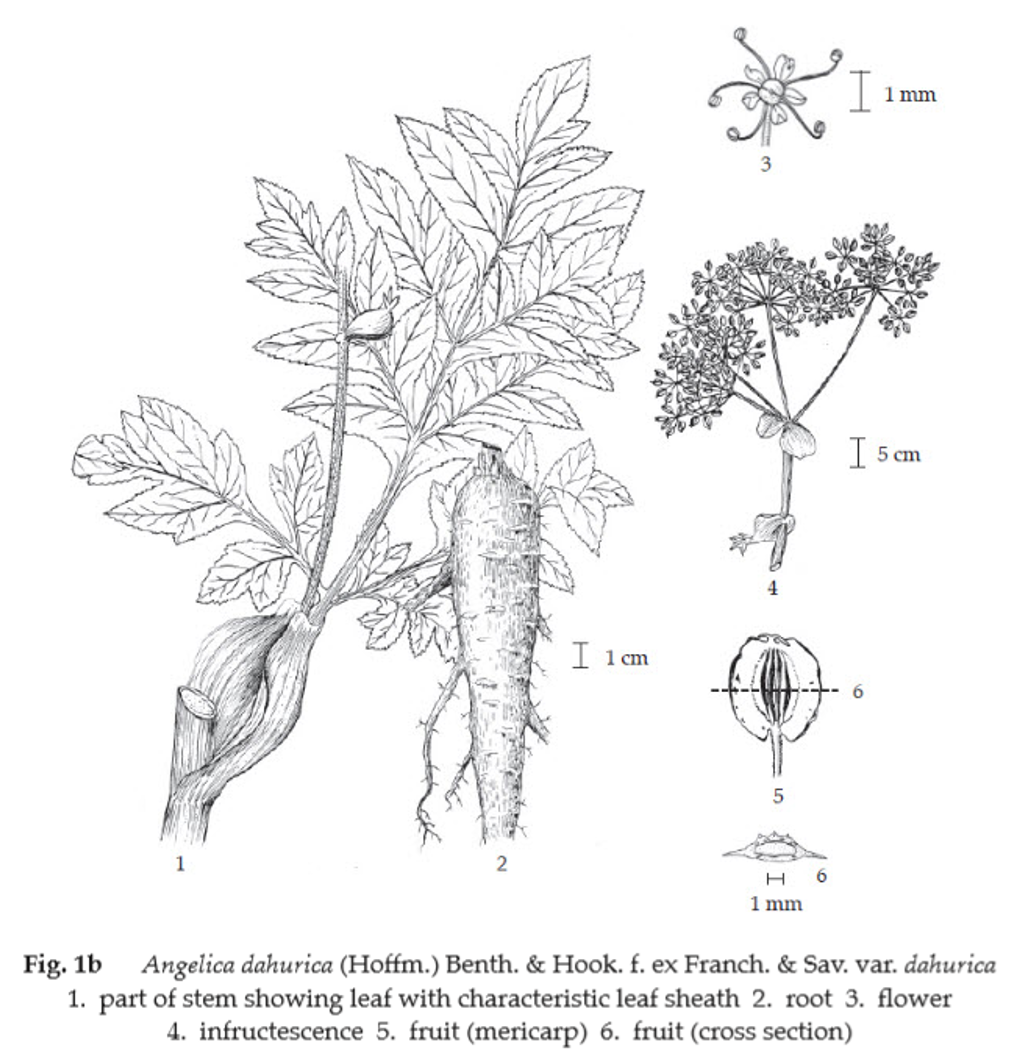
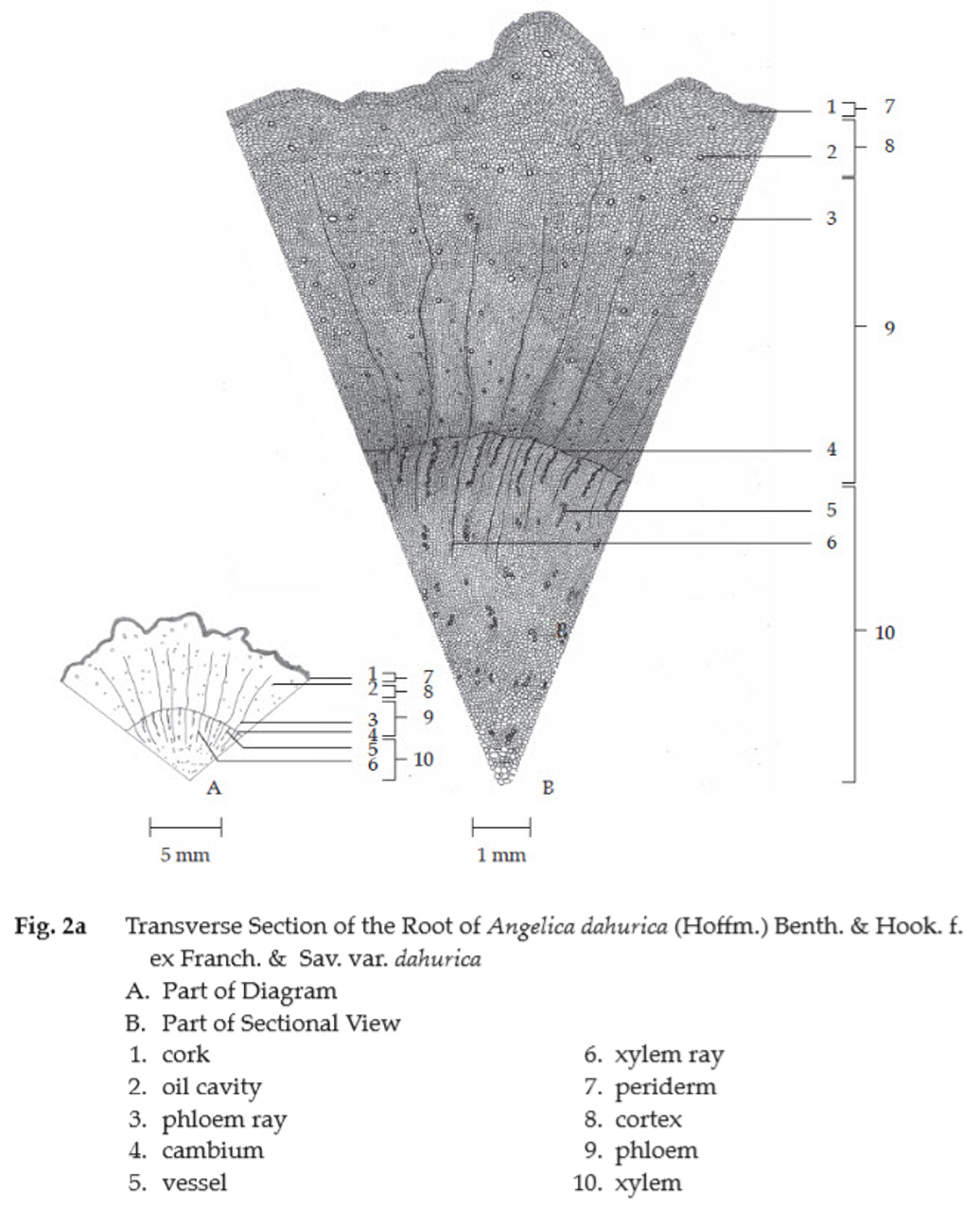
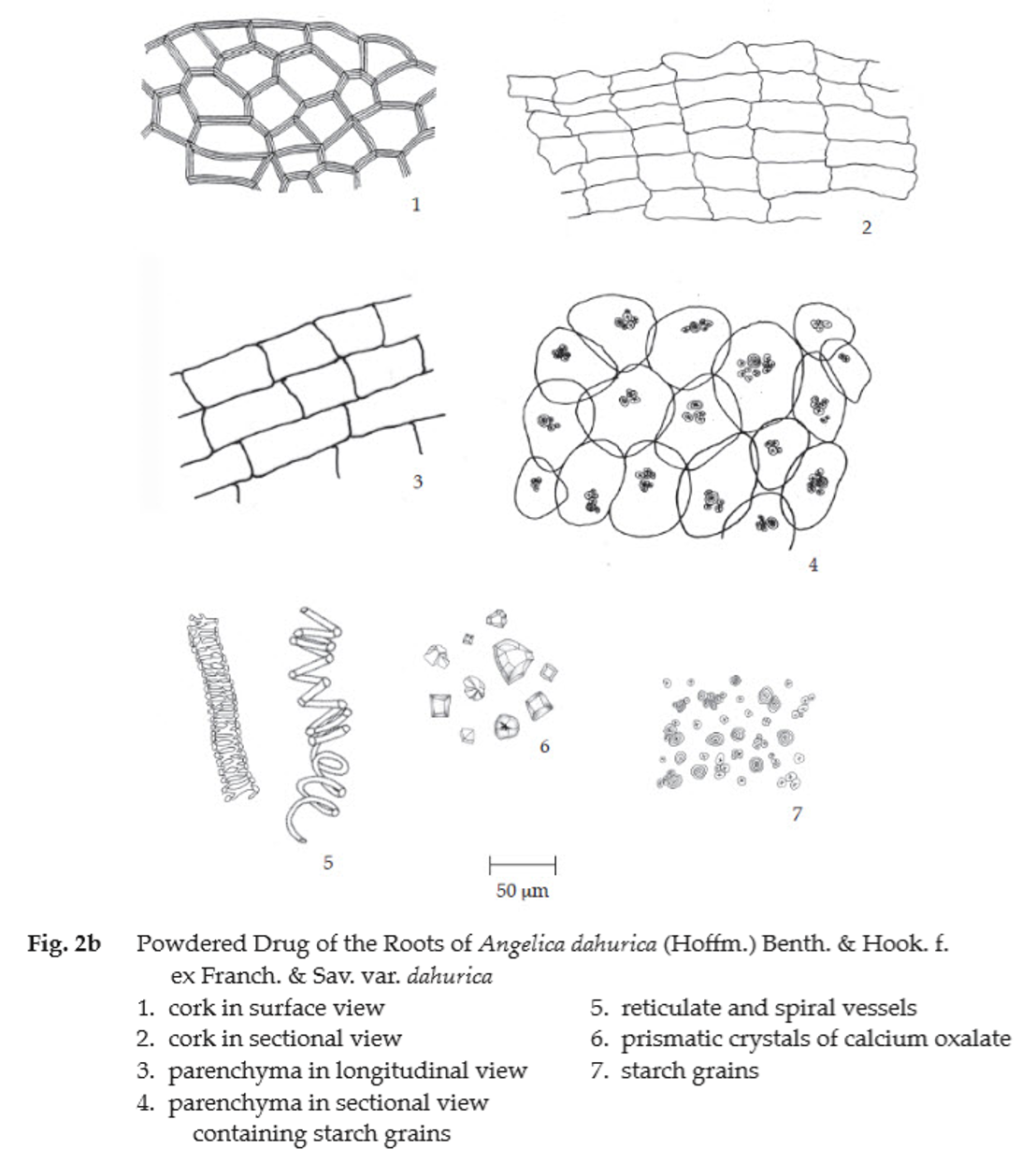
Dahurian Angelica Root in powder possesses the diagnostic microscopical characters of the unground drug. Thin-walled cork cells, abundant parenchyma cells (mostly with starch grains and/or prismatic crystals of calcium oxalate) and abundant starch grains of different shapes and sizes (with prominent lamella and hilum) are commonly found.
Additional information
1. Dahurian angelica plant is not native to nor commercially cultivated in Thailand. The plant yielding dahurian angelica root is here referred to the herbarium specimen number K001097137, collector’s number C.J. Maximowicz s.n., deposited at the Herbarium, Royal Botanic Gardens Kew (K), London, United Kingdom. The photographic illustration of the specimen can be seen at the Department of Medical Sciences Herbarium (DMSC), Nonthaburi, Thailand.
2. Two varieties of Angelica dahurica (Hoffm.) Benth. & Hook. f. ex Franch. & Sav., var. dahurica and var. formosana (Boiss.) Shan et Yuan, are official in the Pharmacopoeia of the People’s Republic of China 2010. However, only the prior variety is imported from China and sold in Thai herbal markets as KOT SO.
3. It is commonly used with other herbal drugs in Thai traditional herbal preparations.
Packaging and storage Dahurian Angelica Root shall be kept in well-closed containers, protected from light, and stored in a dry place.
Identification
A. To 200 mg of the sample, in powder, add 5 mL of ethanol, shake, allow to stand for 5 minutes, and filter. Drop the filtrate on a filter paper moistened with 1 M sodium hydroxide and examine under ultraviolet light (366 nm): a green fluorescence is produced.
B. Carry out the test as described in the “Thin-Layer Chromatography” (Appendix 3.1), using silica gel GF254 as the coating substance and a mixture of 75 volumes of toluene, 25 volumes of ethyl acetate and 5 volumes of glacial acetic acid as the mobile phase. Apply separately to the plate, as bands of 10 mm, 20 μL of solution (A) and 10 μL of solution (B). Prepare solution (A) by refluxing 1 g of the sample, in powder, with 10 mL of dichloromethane for 30 minutes and filtering. Evaporate the filtrate to dryness and dissolve the residue in 1 mL of toluene. For solution (B), dissolve 1 mg of imperatorin in 1 mL of methanol. After removal of the plate, allow it to dry in air and examine under ultraviolet light (254 nm), marking the quenching bands. The chromatogram obtained from solution (A) shows a quenching band (hRf value 66 to 76) corresponding to the imperatorin band from solution (B), and several quenching bands are also observed (Table 1); see also Fig. 3. Subsequently examine the plate under ultraviolet light (366 nm) through the cut-off filter; the band due to imperatorin exhibits a yellow fluorescence. Other several fluorescent bands are also observed. Spray the plate with a 5 per cent w/v solution of potassium hydroxide, and examine the plate under ultraviolet light (366 nm) through the cut-off filter; the band corresponding to imperatorin is orange fluorescence. Several fluorescent bands of different colours are also observed (Table 1); see also Fig. 3.
Table 1 hRf Values of Components in Dichloromethane Extract of the Roots of Angelica dahurica (Hoffm.) Benth. & Hook.f. ex Franch. & Sav. var. dahurica
| Band | hRf Value | Detection | ||
| UV 254 | UV 366 | 5 Per Cent W/V Solution of Potassium Hydroxide and UV 366 |
||
| 1 2 3 4 5 6 7 8 9 10 11 12* 13 14 15 |
13-17 17-20 24-27 30-34 33-42 41-44 43-48 49-53 51-57 59-62 65-69 66-76 75-80 77-83 81-85 |
quenching - - - - - quenching quenching - quenching - quenching - quenching - |
yellow violet violet violet - - blue - intense blue yellow - yellow violet yellow violet |
yellow blue blue blue blue blue blue - instense blue yellow blue orange violet yellow violet |
*imperatorin
Water Not more than 14.0 per cent v/w (Azeotropic Dis tillation Method, Appendix 4.12).
Foreign matter Not more than 2.0 per cent w/w (Appendix 7.2).
Acid-insoluble ash Not more than 2.0 per cent w/w (Appendix 7.6).
Total ash Not more than 5.0 per cent w/w (Appendix 7.7).
Ethanol-soluble extractive Not less than 4.0 per cent w/w (Appendix 7.12).
Water-soluble extractive Not less than 15.0 per cent w/w (Appendix 7.12).
Dose 3 to 9 g, as a decoction, a day.
